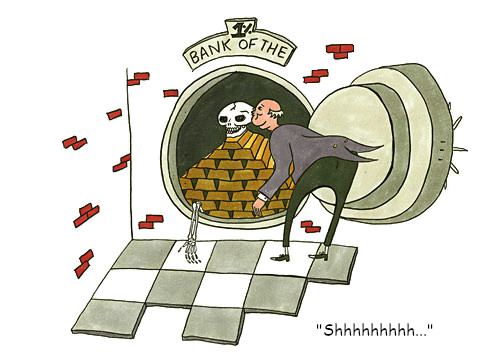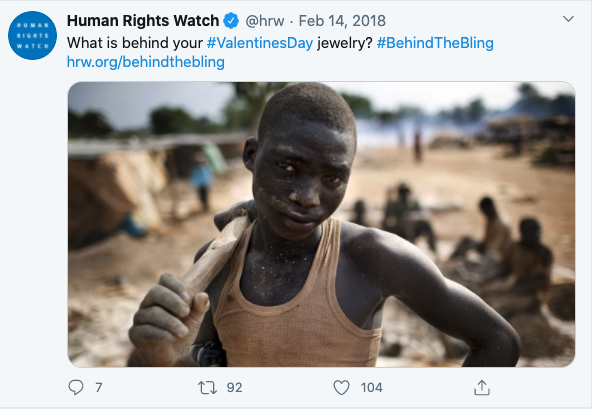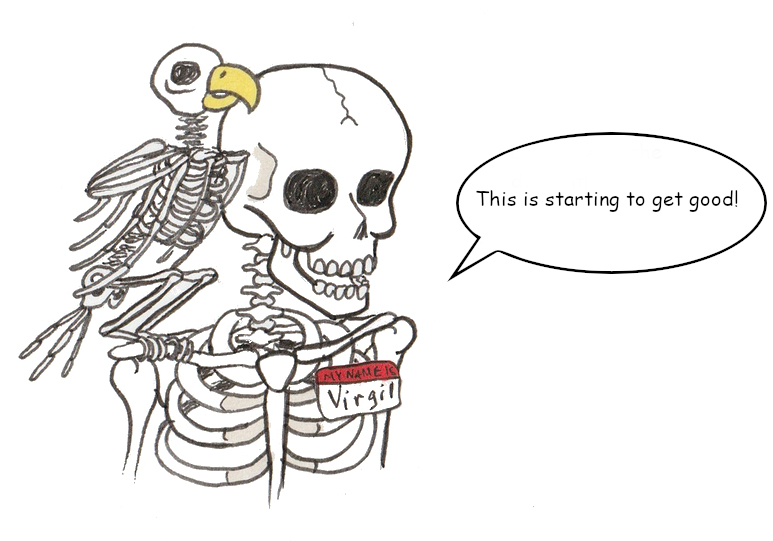“The truth slips out” —I.F. Stone
The Third nesting doll is the Responsible Jewelry Council’s structure: a trade association that presents itself as a nonprofit.
To understand what an organization’s purpose really is, it’s useful to go back to its very inception.
In June of 2009, I published on my Fair Jewelry Action website an interview Greg Valerio conducted with Michael Rae—then the CEO of the Responsible Jewelry Council .
At the time of this interview, the Council was in the process of formulating the standards-setting criteria that would ultimately form the basis for their certification.
The certification system was formally launched in December 2009, six months after this interview.
Back then, the Council was smaller—and nowhere near as influential or powerful in the broader jewelry sphere as it is today.
What seemed most important at the time of publication was Rae’s admission that the Council ’s certification system would not prevent gold mined by child laborers who were using mercury from entering the supply chain.
In retrospect, what Rae revealed about the Council’s structure holds an even greater weight.
Rae states that the Council is creating “a system like the MSC (Marine Stewardship Council) [or] FSC (Forestry Stewardship Council)” and admits that the Council “unashamedly cribbed” from these organizations.
We need to unpack the implications of “unashamedly cribbed.”
The Marine Stewardship Council and Forest Stewardship Council exemplify a radical centrism model. The idea is that you bring together both a broad swath of stakeholders, many of whom might be diametrically opposed, and forge an agreement.
For example, membership of the Forest Stewardship Council might include an environmental group—whose aim is to protect a forest—and a paper manufacturing company—whose aim is decidedly the opposite. The goal of bringing these two together under one roof is to reach an agreement and create a viable path forward.
An effective radical centrist approach exemplifies the aphorism “perfection should not be the enemy of the good.”
Rae has borrowed the language from these models because he wants the Council’s certification process to appear like these models.
He emphasizes that the Council is a standards-setting organization that will look much the same as those well-regarded initiatives when he references “standards we have adopted that have come out of multi-stakeholder processes.”
But then he states something else, which is radical and new: “The methodology that we have used is in essence a trade association with a product stewardship focus.”
In other words, the Council is set up to seem like the Marine and Forest Stewardship Councils, inviting a wide range of parties to the table.
But ultimately, the Responsible Jewellery Council is a trade organization.
This kind of specious reasoning, to emphasize one perspective in order to hide a larger, more important truth, is a common theme in our exploration.
Here’s the Bottom (I mean Babble) Line:
The entire standards-setting process, millions and millions of dollars of consultation, papers, reviews, public participation, obscures what Rae admitted. Let me say it again for emphasis:
The Responsible Jewelry Council is a trade organization.
Decision making is always aligned with its publicly traded corporate interests that are legally bound to protect their assets and maximize value for their shareholders.
The difference between the Responsible Jewellery Council and Marine and Forest Stewardship Councils is radically important. The latter two organizations actually allow a broad swath of oppositional interests to participate in decision-making.
The Responsible Jewellery Council, as a trade organization, focuses on protecting the bottom line of its core founders—and by extension, the mainstream jewelry sector.
Here’s an additional reason why Third Russian Doll is so powerful: it deflects industry watchdogs.
Non-governmental Organizations (NGOs) vs. the Responsible Jewellery Council
Organizations such as Amnesty International, Human Rights Watch, or Global Witness, which exposed blood diamond trafficking, function as a kind of white blood cell response to human rights violations and threats to our environment.
In fact, several NGOs are specifically focused on issues related to the impacts of mining and the larger jewelry industry. But importantly, if an NGO criticizes the jewelry sector from the outside, without appearing to work toward bipartisan efforts within the larger industry, they are written off and dismissed as unwilling to work with the jewelry trade to provide realistic solutions.
So, NGOs engage constructively with the Responsible Jewellery Council—which represents core interests in the jewelry sector and, after all, is setting ethical standards.
But this engagement has become a kind of quagmire, a Catch 22.
From the beginning, Council standards have been questioned by NGO watchdogs.
In 2009, after the Council standards were published, nine NGOs and labor organizations jointly put out this press release denouncing them:
“The standards would let companies operate mines in conflict zones and in most protected areas; would allow dumping of tailings waste into lakes and deeper ocean waters; and provide limited or no control on emissions of toxic substances to the environment. The standards also lack provisions for community consent for mining operations or resettlement...”
Earthworks, which signed the letter, also held out some hope. They wrote a letter to CEO Rae stating they were “committed to a multi-stakeholder approach to standards setting and third-party certification” and referenced standards expert Michael Conroy, who had served as the Board Chair of the very Forest Stewardship Council that Rae “unashamedly cribbed” from.
Conroy pointed out here that, for standards to be valid, they must be “created jointly by the full set of stakeholders negotiated by industry representatives and representatives of social, environmental, and community organizations, then audited annually by a totally independent outside organization.”
Here’s the key subtlety:
The social, environmental, and community organizations that the Responsible Jewellery Council invites have little influence over key decisions regarding standards. Just because you have a seat at the table doesn’t mean your voice will be heeded.
Thus, the core critique leveled back in 2009 has remained a kind of constant: invitation to participate but no real power of influence.
By May 2013, Earthworks correctly assessed that the Council had shut them out.
Earthworks published a report entitled More Shine Than Substance: How RJC Certification Fails to Create Responsible Jewelry, together with Mining Watch Canada, Construction Forestry Maritime Mining and Energy Union, and United Steelworkers.
The title is self-explanatory. But again, one of the central criticisms of the Council in this study is the fact that it is not a true multisector initiative.
To quote from the executive summary, “the Responsible Jewellery Council system and its components are riddled with flaws and loopholes… rendering it an ineffective tool by which to create an environmentally and socially responsible supply chain in the jewelry industry.”
{Brilliant Earth's endorsement of the RJC, despite reports like this from Earthworks, was a major motivator behind the Eight Russian Doll. See that piece for more.]
More specifically, from pages 12-13:
1:)The RJC (Responsible Jewellery Council) is exclusively industry-controlled and governed, leaving civil society out of decision-making or oversight. There is no way to publicly track or view complaints that have been lodged regarding RJC’s certification process or the certification of an individual member.
2) RJC fails to include and respect the voices of those most affected by jewelry-supply-chain practices,
3) Certification is based on standards that fail to fully protect communities, workers and the environment,
4) Multiple loopholes in the certification process weaken the system’s legitimacy,
5) The certification system has virtually no public transparency or accountability,
6) The complaints system is inadequate and RJC-controlled rather than independent.
In 2013, when More Shine Than Substance was published, there were just 450 Responsible Jewellery Council members. And in June of that year, the Council issued a very robust response to the main points of the report.
Currently, the Council has over 1100 members. In other words, the Earthworks publication did not slow the momentum of the Council one bit.
Current Critiques of the Responsible Jewellery Council
In early 2018, Human Rights Watch published a 99-page study, The Hidden Cost of Jewelry. Much of the critique is an updated version of More Shine Than Substance.
Quoting from the report:
“The RJC consults civil society and other actors and includes civil society representatives on its standard-setting committee, but is essentially an industry body. Its decision-making bodies do not include consumer groups, representatives of mining communities (for example, organizations addressing land rights or environmental harms), trade unions or miners’ associations, or human rights NGOs”
Additionally, Human Rights Watch writes in their call to action signed by 29 Non-government organizations, including Amnesty International, Global Witness, and Impact:
“The Responsible Jewellery Council promotes standards that allow companies to be certified even when they fail to support basic human rights.”
This is generally the same conclusion that was reached back in 2009!

Between then and now, NGOs have not been negotiating with the Council on the assumption that it is a non-profit organization which shares common values instead of a trade association composed of major multinationals focused on protecting assets, profits, and global shareholder investments.
Unlike in 2013, the Council in 2018 does not even respond directly to Human Rights Watch’s The Hidden Cost of Jewelry.
They don’t need to, because they have already set the perfect trap. The NGOs have been inadvertently legitimizing Council by engaging with them over the years. This engagement has only reinforced the Council’s global power and stature.
Thus, the CEO of Signet Jewelers, Virginia C. Drosos, responds to Human Rights Watch —on behalf of Council—with as follows:
“In the spirit of transparency and cooperation, Signet and other members of the jewelry industry engaged openly and extensively with Human Rights Watch. Unfortunately, the report contains language chosen more to criticize our industry rather than provide constructive recommendations.”
Pause with me for a moment. Let’s back up together and go through that again.
The Council felt no need to even respond to this thorough, 99-page criticism by Human Rights Watch.
Instead, the CEO of a major jewelry retailer, a Council member, speaks on the Council’s behalf with a consummate dismissal, using the NGOs engagement against them in an aikido-like manner.
From another perspective, Human Rights Watch and the 29 NGOs that signed on with them are brushed off like an annoying housefly. Human Rights Watch’s efforts come across as the equivalent of trying to attack an entire division of modern-day tanks with a few soldiers armed with pea shooters.
Unfortunately, the framers of the Human Rights Watch initiative do not understand how one plus one can equal eleven, or even twenty-nine. We need a system-thinking approach that considers multiple levels of complexity: i.e. Russian nesting dolls.
Because HRW is more symptom- than system-oriented, they fail not only to locate and activate the energy for change, but misdirect it. You have to find ways beyond polite tweets (such as in the screenshot below) to shift the market, and only the threat of making less money or the possibility of making more money will change the behavior of these large companies.
This is the way Capitalism is set up!

As this dynamic requires a more detailed analysis, I have written an entire supplementary article, Human Rights Watch's "Behind the Bling": A Strategic Analysis.
Let’s get back to our Russian doll and continue our descent toward the center!

Continue onto the Fourth Russian Doll: The Responsible Jewellery Council Chain of Custody Scheme
Return to the Second Russian Doll: The Responsible Jewellery Council
Return to the Landing Page

**All writing and images are open source, under Creative Commons 3.0. Any reproduction of this material must back link to the landing page, here. For high resolution images for publication, contact us at expose(AT)reflectivejewelry.com.**